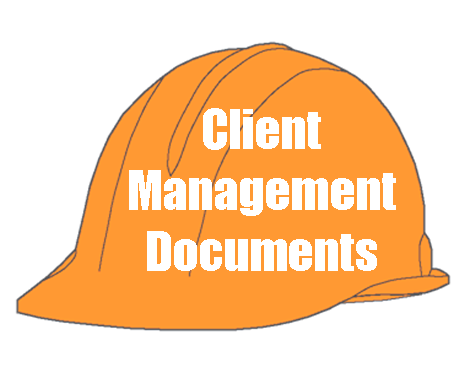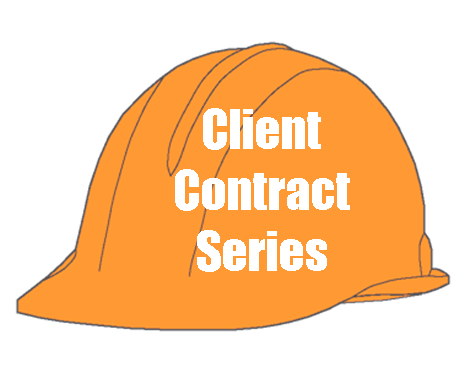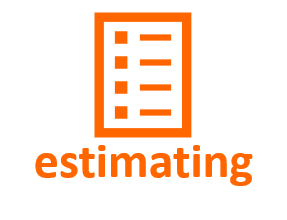CLIENT MANAGEMENT
The Client Contract Series
This discussion is presented as a matter of business management. Any action on your part should be discussed with your legal counsel. Builder-Resources.com is not a legal advisor, and is not practicing law by discussing this business document. Please refer to the Builder-Resources.com site disclaimer.
The Client Contract Series covers the agreements that are useful for defining the business relationship between your company and the client as you go through the process of conceptualizing, designing and building the custom residence. The series includes:
|
Samples AvailableCustomizable samples of these actual documents are available for purchase. See information in the "Buy Downloads" box to the right. |
A quick comment regarding the design contracts. It is important to stress to the client that they are under no obligation to proceed to each subsequent step in the process. They can take the designs to any other designer or architect to complete the drawings or to produce construction drawings. You are interested in assisting the client in arriving at the best project design possible, and will be happy to build their project from plans developed by any other professional.
The Schematic Design Agreement
This is the first step in the design process. The proposed structure begins to take on a personality, with general outlines for rooms, window and door locations, preliminary kitchen and bath layouts, and notes concerning the client's design suggestions.
Elevations show what the exterior lines of the house will look like. Drawings include exterior wall elevations, roof line, windows and exterior doors and several 3-D perspectives of the concept.
A preliminary budget for the house is prepared using standard specifications, except where client has suggested alternative specifications.
The Design Development Agreement
In this step, you develop greater specificity based on schematic design. Decorative details are drawn, storage details are produced. Bathroom and kitchen details and specifications are determined.
Material specifications are determined based on client request and budget parameters. A specifications folder (electronic and/or hardcopy) is prepared.
Detailed drawings of special design area (moldings, bookcases, fireplaces, etc.) are completed.
A more detailed budget is prepared. This budget should show the cost of customer specification requests and alternatives to assist the client to stay within budget constraints.
The Construction Drawings Agreement
In the final design step, you will develop a construction set of drawings. Client is advised that this is the information from which the house will be built.
The drawings include design details and uploads of specifications, with engineering details for structural and seismic considerations. Roof structural design, point loads, bearing locations, framing connections, and structural component design are all included.
Trade (HVAC, plumbing, electrical, fire abatement) drawings are developed and included, as necessary.
The Company Scope of Work is included. This is a statement of what the Company will and will not accept as its construction responsibility.
The summary of work to be done by others, outside the Scope of Work for the Company, is detailed.
Energy compliance calculations are made and documented.
A final budget, based on all known client specifications, is detailed and produced. This will become the contract amount, and should be as accurate as possible for this point in the process.
When you have completed this process, you should have everything necessary to proceed to the construction permit once the Construction Agreement has been executed.
The Construction Agreement
The Construction Agreement is the controlling document for the actual construction of the residence. It must include all of the understandings between the parties, and, to a large degree, anticipate how various problems which might arise will be resolved.
The Builder-Resources Construction Agreement is an evolutionary document that has tended to grow as new issues have come up over the years.
I have included the sections of the document below with notes regarding important clauses of each section.
Components of the current Construction Agreement include:
1. Purpose of the Agreement - Purchaser, as General Contractor, is employing the Company, as a subcontractor, to oversee construction. The relative responsibilities of the parties are established immediately.
2. Responsibilities under the Agreement - Purchaser is the General Contractor. Company is a subcontractor. A further clarification of the roles of the parties.
3. Agreement documents - This Agreement, Floor plans and Elevations, Standard Specifications, Mold Disclaimer and Waiver, Builder Limited Warranty
4. The Work - Nothing outside the foundation. "Substantially in conformance" with designs and plans.
5. What the Company is not responsible for - Includes items such as hauling debris, off-site utility trenches, concealed conditions. Review this section on every job to add or delete per what has been agreed upon.
6. Financing - Agreement is contingent on meeting payment schedule. Start date contingent on satisfactory evidence that final payment can be made.
7. The Agreement Price - From final budget
8. How payments are to be made - 30%, 30%, 30%, 10% at specific milestones.
9. Acceptance and final payment - Three days to inspect, payment upon acceptance. Assumption of acceptance if no inspection made.
10. Commencement and Completion - Specific number of days, beginning after issuance of building permit. Exclusions for Client acts, weather, concealed conditions.
11. Other Subcontractors and Employees - Client, as General Contractor, can hire others for which the company bears no responsibility.
12. Selections - Specifications have a due date, after which The Company will make choices and Client approves such choices in advance.
13. Substitution of Materials - Structural materials and generic items can be substituted as long as there is no decrease in quality.
14. Substitution of Design Features - Company can change design features (door sizes, window sizes, etc.) as required by code or building process.
15. Escalation Clause for Building Materials - If material prices increase after contract signed, the Client agrees to pay increase.
16. Special Circumstances - Right of Termination - If the general prices increase more than a set percentage, Client can terminate contract with certain payment to The Company.
17. Health Concerns Arising From Materials Used in Construction - Client may request samples of any building product to test for harmful effects. Company gets copy of all test. Absence of request equals acceptance of products.
18. Permits, Fees and Tests - Defines which party pays for which permits, fees, and tests.
19. Taxes - Defines which party pays for which taxes.
20. Change Orders - Changes are expected and allowed. Only accepted if written and signed. Overhead percentage added to each change. Evidenced by "Customer Instructions".
21. Insurances - Company will maintain necessary insurances.
22. Purchaser Obligations - Purchaser will not obstruct construction process in any way.
23. Concealed or Weather-Related Conditions - Company has not investigated site conditions on Client's lot.
24. Soil Engineer's Report - Client's responsibility to secure a soils report.
25. Radon - Company has no responsibility for radon occurrences.
26. Radon Disclaimer and Waiver - Large, bold all caps disclaimer and waiver.
27. Disputes - Arbitration, Company reserves right to address deficiencies.
28. Termination - Client has right to assume Project Manager duties, Company entitled to full project payment.
29. The Limited Warranty - Limited warranty is only warranty.
30. Miscellaneous - Company signs on site allowed, unlimited use of photographs of project on Company website and in Company marketing.
The Exhibits
Floor Plans and Elevations
Final iteration of drawings, usually the result of the Construction Drawing Agreement. If the plans have been generated elsewhere, the title, date, and iteration of the plans is noted in the Construction Agreement.
Initial Specifications
This is a copy of the specifications developed using the process outlined here. It represents only the known specifications at the time of contract, of course, and allows for additional changes.
It is important to include these initial specifications as they form the basis for any changes made in later iterations and formalized in the Confirmation of Instructions.
Mold Disclaimer and Waiver
The issue of mold in the home has declined in the last couple of years, but can have devastating implications for the builder. This document discusses the causes of mold growth in the home, explains that much of the prevention relies on housekeeping, provides a prevention regimen, and includes a mold disclaimer and waiver for the builder.
The client has ample time and opportunity to inspect the premises for mold prior to occupancy. After that, absent construction problems, mold growth is essentially an occupancy issue.
Components of the Mold Disclaimer and Waiver include:
1. What the Client should know about mold.
2. Homeowner mold prevention steps.
3. Mold prevention resources.
4. Mold disclaimer and waiver.
Builder Limited Warranty
The document, issued as a component of the Construction Contract, is a "Sample" because the actual Builder Limited Warranty is only issued at the completion of the construction.
It is included as part of the Construction Agreement to allow the Client to review the limited warranty, but does not become effective until all payments pursuant to that agreement have been satisfied.
Components of the Builder-Resources Builder Limited Warranty include:
1. It is a Limited Warranty.
2. A specific beginning and ending date.
3. An explanation of limited coverage.
4. Specific exclusions.
5. A list of "pass-through" warranties.
6. The Company rights with regard to warranty service.
7. Warranty limitations.
8. Maintenance requirements by Purchaser.
9. Non-warrantable conditions.
10. Warranty remedies available to the Client.
11. Warranty disclaimer.
I don't know if I can say it enough times, so I'll say it once more. This discussion is about the business aspects of these agreements which I use in my business. If you decide to use any of the above information or documents in your business, be sure to discuss any such use with your legal counsel.
View the Slide Deck for Client Contracts














